The artwork of an artist is influenced by his or her environment; therefore, art will often echo that of its time and place. In 1960, Jasper Johns created his lithograph “0 through 9”, using stone in black on Arches paper. Joseph Mallord William Turner created his oil on canvas painting the “Keelmen Heaving in Coals by Moonlight” in 1835. The information below will compare and contrast the periods and culture of these two pieces of artwork.
The 1960 lithograph “0 through 9” was created during the 20th-century. This period is signify the point when western art changes. It was during this period that Abstract Expressionism artists came to light. The culture of this period brought about the many changes to the Civil Rights movement. It is identified with the many sit-ins and peaceful protects organized by such leaders as Martin Luther King and Stokely Carmichael.
Where as, the 1835 oil painting “Keelmen Heaving in Coals by Moonlight was painted during the Modern Art period which took place during the nineteenth century. The Modern Art period was between 1800 through 1945. The culture of this period allowed married women the ability to retain their own property. It was also during this period that many technological changes took place in the world.
In conclusion, the two pieces of artwork chosen identifies two of the different periods in art history. Since both are from different periods, the cultures are dissimilar as well.
Wednesday, October 31, 2007
Wednesday, October 24, 2007
Activity #10 Mediums and Techniques
In 1960, Jasper Johns created “0 through 9”, using stone in black on Arches paper. The medium used is lithography. Lithography is a printmaking technique. Lithography was invented by Alois Senefelder a young German actor and playwright in the 1790s. (199) Lithography is a planographic process, which means that the printing surface is flat – not raised as in relief or depressed as in intaglio. (200) Lithographic print is created by drawing the image on stone using a greasy material; “tusche”, and then using an acid based solution which enable the print to adhere to the stone thus preparing it for printing. Lithography is a remarkably flexible medium and capable of a broad range of effects. (202) This is seen by the way Johns uses thin lines to represent the numbers, “0 through 9”. The thin lines are black and embedded on the stone to create the overlapping of numerals. When looking at the painting, your eyes are drawn to the visual elements of the diagonal lines Johns uses to convey direction and motion. (82) Thus, creating a surface which is considered to be active to anyone looking at the piece of artwork. When looking at this lithograph, one can see the importance of the numbers. Each represents a number which is unique from the others.
Joseph Mallord William Turner’s 1835 painting “Keelmen Heaving in Coals by Moonlight” utilizes the medium of oil painting on canvas. It is say that oil painting was invented in the 15th century and consist of pigment compounded with oil, usually linseed oil. (172) An advantage of oil is that it is a medium that can be worked in an almost infinite range of consistencies, from very thick to very thin. (175) This painting has areas in which Turner uses thick and thin brush strokes. This is especially the case when you look at the way he uses thick and thin brush strokes to represent the sky. For the moon’s reflection on the water, he uses heavy brush strokes. This technique is called “impasto”. Impasto is a technique from the Italian for “paste” where paint is layered thick. (175) This technique allows Turner to create the atmospheric perspective of the moon setting for the evening providing light while the keelmen work through the night. To accomplish this effect, Turner uses value to create lighting and darkening effect seen in the painting. Value is shades of light and dark (92) He also uses broken color by tinting the sky using blue and white paint.
In conclusion, both artists have created beautiful pieces of artwork. The medium used by Johns is lithograph while Turner uses oil on canvas.
Joseph Mallord William Turner’s 1835 painting “Keelmen Heaving in Coals by Moonlight” utilizes the medium of oil painting on canvas. It is say that oil painting was invented in the 15th century and consist of pigment compounded with oil, usually linseed oil. (172) An advantage of oil is that it is a medium that can be worked in an almost infinite range of consistencies, from very thick to very thin. (175) This painting has areas in which Turner uses thick and thin brush strokes. This is especially the case when you look at the way he uses thick and thin brush strokes to represent the sky. For the moon’s reflection on the water, he uses heavy brush strokes. This technique is called “impasto”. Impasto is a technique from the Italian for “paste” where paint is layered thick. (175) This technique allows Turner to create the atmospheric perspective of the moon setting for the evening providing light while the keelmen work through the night. To accomplish this effect, Turner uses value to create lighting and darkening effect seen in the painting. Value is shades of light and dark (92) He also uses broken color by tinting the sky using blue and white paint.
In conclusion, both artists have created beautiful pieces of artwork. The medium used by Johns is lithograph while Turner uses oil on canvas.
Critical Thinking Essay - By Renee and Yvette
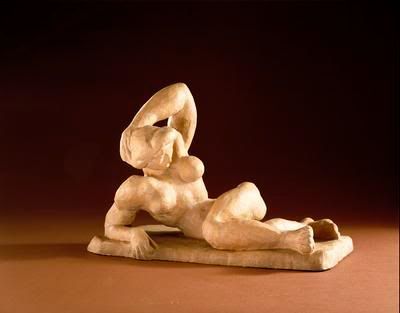
The two masterpieces that we would rescue from the Hirshhorn Museum and Sculpture Garden in Washington, DC before the meteorite hits and destroys the museum are “Reclining Nude I” and “Study of Portrait of Van Gogh III”. We selected the “Reclining Nude I” by Henri Matisse, in 1907, for its use of terra cota as the medium and the strong depiction of the female form. This sculpture symbolizes woman and her strength in body and soul to endure life and its many hardships. This is seen by the way Matisse sculpted the figure in a muscular form. Muscles usually symbolize strength. Therefore, one can assume that this woman is strong in character. Strength has normally been a characteristic associated with males. We also chose it for the strange way that the female figure is posed and the artist technique of rounding the breast and strong muscular features of the arms and hips. This type of pose is considered a “contrapposto, meaning counterpoise or counterbalance, which sets the body in a gentle S-shaped curve through a play of opposites” and if one was to stand over this piece, they would see the S-shape. (pg 279) Matisse use of monochromatic harmonies in this artwork brought out different aspects of the posed body, by using the rich cream color. This beautiful sculpture also represents a three dimensional space, as you follow the contours of the right arm, alongside the upper torso, around to the back of the sculpture. You are drawn right away to the upper torso, with the arm relaxed behind the head, giving emphasis to the perfectly rounded breasts. The next thing you notice is the chiseled physic of the female figure, which is unusual for a female. Matisse also tried to capture a more feminine look with the French hairstyle, creating a softer look around the facial features.

We selected to save the strange but interesting masterpiece by Francis Bacon, titled “Study for “Portrait of Van Gogh III”, in 1957, for an entirely different reason from why we chose the “Reclining Nude I”. We chose to save Bacon’s masterpiece because of the artist use of multiple mediums, oil paint and sand on linen, creating a grainy texture to the surface of the cloth. In addition, Bacon used brushstrokes which were bold and thick creating a layered surface which stands out in the art piece. To accomplish this effect, he used the technique called “impasto”. “Impasto is from the Italian for “paste”, a thick application of paint”. (pg 175) This created a landscape surface which appears to be smooth as well as rough in certain areas. The artist also used two different directional patterns in the foreground and background, giving the painting a distorted look. The stark contrast of the trees and male figure brings emphasis to the subject of Van Gogh, as a lonely figure walking along the road of life. This is also a great piece of art to be saved for future generations to aspire, with its use of vivid colors in his representation of the landscape. Bacon uses primary and secondary colors: red, yellow and green, to create a colorful composition with combination of blue representing the darkness of the sky.
In conclusion, these two wonderful masterpieces by Henri Matisse and Francis Bacon, were the only two that we would select to rescue from this terrible disaster at the museum, they really appealed to our sense of art design. The different mediums and techniques for both artworks allowed us to understand the subject of both pieces and detail the difference in design elements. The sculpture and the painting were both a thing of beauty to behold; artworks we would like to have in our homes.
Thursday, October 18, 2007
Wednesday, October 10, 2007
Activitty #7
The artwork in this exhibition represents the art theme “Art and Nature”. This exhibit features several pieces of art from various painters such as Albert Bierstadt, Frederic Edwin Church, Sanford Robinson Gifford, George Inness, Georgia O’Keefe, and Sergeev Vladimir whom work utilized the theme “Art and Nature”. Each piece is set using nature as its backdrop.
The exhibition will display the artwork of these six artists. Their work will be showcase in chronological order. The first showcase will contain two works of art by Albert Bierstadt (1830-1902); Lake Lucerne and The Rocky Mountains, Lander’s Peak. The second showcase will consist of two paintings by Frederic Edwin Church (1826 – 1900); El Rio de Luz (The River of Light) and Heat of the Andes. The third case will display Sanford Robinson Gifford (1823-1880), A Gorge in the Mountains (Kauterskill Clove). The fourth showcase will feature the work of George Inness (1825-1894); the Autumn Oaks. The fifth showcase is a painting by Georgia O’Keefe (1887-1986); Sky with Flat White Cloud. The final showcase will feature artwork by Sergeev Vladimir to include Mountain Motif and Evening Landscape both created in 2003.
Albert Bierstadt created his oil on canvas paintings The Rocky Mountains, Lander’s Peak in 1863 and Lake Lucerne in 1858. In both paintings, the elements Bierstadt uses are implied lines and atmospheric perspective. Both have mountains which appear to be farther away in the distance. They are blurred and misty shapes. In The Rocky Mountains, Lander's Peak, the color white is used to create the illusion of a waterfall with water cascading down the mountain to create a downward diagonal movement into to the stream below. The implied line of the water create the illusion of there being a stream that surrounds the mountain. In Lake Lucerne painting, there is a dirt road in which the eyes can follows through the trees.
Frederic Edwin Church oil on canvas painting El Rio de Luz (The River of Light) in 1877, he has created a tropical rainforest setting in which the viewer can envision they have been given the opportunity to witness the dawn of creation itself. This is seen by the way Church has used the value of lightening and darkening the color of the sky.
In 1862, Sanford Robinson Gifford created his oil on canvas painting A Gorge in the Mountains (Kauterskill Clove). The interesting element about this painting is Gifford’s use of movement. He used the value of lightening and darkening the sky to create the illusion that the clouds are moving. Another element he uses is implied diagonal lines. This is seen by looking at the pathway created by cows as their wander down to graze in the meadow. The grass where there is movement is bare.
George Inness in 1878 created his oil on canvas painting Autumn Oaks. This painting uses the element of atmospheric perspective where as the hills in the background are meant to appear farther away. When looking at the hills, they are blurred and misty; therefore, creating the appearance of being distance. He also has lightened the sky to create a focus point of being far off. There is also direction and movement by the lines implied when looking at the way the land appears to being moving down from left to right as well as the land background appearing to being going down.
Georgia O’Keefe created her oil on canvas painting the “Sky with Flat White Cloud” in 1962. This paining demonstrates balance where as no one element dominates. This artwork depicts symmetrical balance. If an imaginary line was drawn down the middle, both sides would match up in size, shape, and placement.
Sergeev Vladimir created the paintings “Mountain Motif and Evening Landscape” both oil on canvas in 2003. In Mountain Motif, Vladimir uses primary and secondary colors; blue, red and green to represent the landscape, mountains and sky. He uses the element of intensity by the creating a duller shades of blue to create the illusion of the mountain appearing farther away in the distance. In Evening Landscape, he uses the primary color blue to represent the sky where as tertiary colors are used for the land, i.e. red-orange. To emphasis the hills in the background, Vladimir has made them standout, therefore, making them the focus point.
The exhibition will display the artwork of these six artists. Their work will be showcase in chronological order. The first showcase will contain two works of art by Albert Bierstadt (1830-1902); Lake Lucerne and The Rocky Mountains, Lander’s Peak. The second showcase will consist of two paintings by Frederic Edwin Church (1826 – 1900); El Rio de Luz (The River of Light) and Heat of the Andes. The third case will display Sanford Robinson Gifford (1823-1880), A Gorge in the Mountains (Kauterskill Clove). The fourth showcase will feature the work of George Inness (1825-1894); the Autumn Oaks. The fifth showcase is a painting by Georgia O’Keefe (1887-1986); Sky with Flat White Cloud. The final showcase will feature artwork by Sergeev Vladimir to include Mountain Motif and Evening Landscape both created in 2003.
Albert Bierstadt created his oil on canvas paintings The Rocky Mountains, Lander’s Peak in 1863 and Lake Lucerne in 1858. In both paintings, the elements Bierstadt uses are implied lines and atmospheric perspective. Both have mountains which appear to be farther away in the distance. They are blurred and misty shapes. In The Rocky Mountains, Lander's Peak, the color white is used to create the illusion of a waterfall with water cascading down the mountain to create a downward diagonal movement into to the stream below. The implied line of the water create the illusion of there being a stream that surrounds the mountain. In Lake Lucerne painting, there is a dirt road in which the eyes can follows through the trees.
Frederic Edwin Church oil on canvas painting El Rio de Luz (The River of Light) in 1877, he has created a tropical rainforest setting in which the viewer can envision they have been given the opportunity to witness the dawn of creation itself. This is seen by the way Church has used the value of lightening and darkening the color of the sky.
In 1862, Sanford Robinson Gifford created his oil on canvas painting A Gorge in the Mountains (Kauterskill Clove). The interesting element about this painting is Gifford’s use of movement. He used the value of lightening and darkening the sky to create the illusion that the clouds are moving. Another element he uses is implied diagonal lines. This is seen by looking at the pathway created by cows as their wander down to graze in the meadow. The grass where there is movement is bare.
George Inness in 1878 created his oil on canvas painting Autumn Oaks. This painting uses the element of atmospheric perspective where as the hills in the background are meant to appear farther away. When looking at the hills, they are blurred and misty; therefore, creating the appearance of being distance. He also has lightened the sky to create a focus point of being far off. There is also direction and movement by the lines implied when looking at the way the land appears to being moving down from left to right as well as the land background appearing to being going down.
Georgia O’Keefe created her oil on canvas painting the “Sky with Flat White Cloud” in 1962. This paining demonstrates balance where as no one element dominates. This artwork depicts symmetrical balance. If an imaginary line was drawn down the middle, both sides would match up in size, shape, and placement.
Sergeev Vladimir created the paintings “Mountain Motif and Evening Landscape” both oil on canvas in 2003. In Mountain Motif, Vladimir uses primary and secondary colors; blue, red and green to represent the landscape, mountains and sky. He uses the element of intensity by the creating a duller shades of blue to create the illusion of the mountain appearing farther away in the distance. In Evening Landscape, he uses the primary color blue to represent the sky where as tertiary colors are used for the land, i.e. red-orange. To emphasis the hills in the background, Vladimir has made them standout, therefore, making them the focus point.
Activity #6 - Mid-Term
Theme: Art and Nature
Albert Bierstadt
Lake Lucerne, 1858
Oil on canvas
Borrowed from the National Gallery of Art
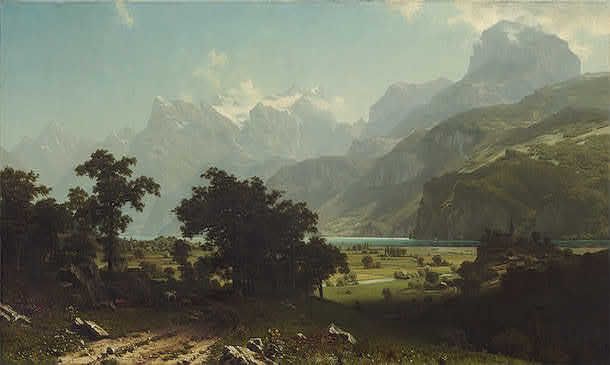
Frederic Edwin Church (1826 - 1900)
Heart of the Andes, 1859
Oil on canvas
Borrowed from the Metropolitan Museum of Art

Sanford Robinson Gifford (1823-1880)
A Gorge in the Mountains (Kauterskill Clove), 1862
Oil on canvas
Borrowed from the Metropolitan Museum of Art
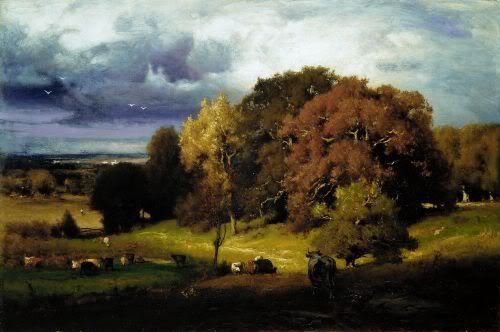
Albert Bierstadt (1830-1902)
The Rocky Mountains, Lander's Peak, 1863
Oil on canvas
Borrowed from the Metropolitan Museum of Art
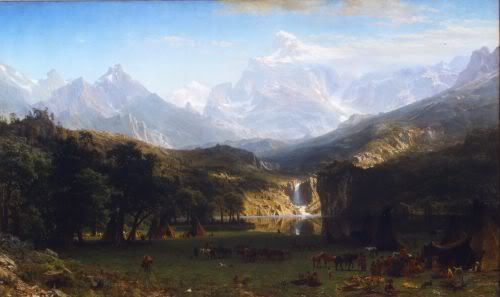
Frederic Edwin Church (1826 - 1900)
El Rio de Luz (The River of Light), 1877
Oil on canvas
Borrowed from the National Gallery of Art

George Inness (1825-1894)
Autumn Oaks, ca. 1878
Oil on canvas
Borrowed from the Metropolitan Museum of Art

Georgia O'Keeffe (1887 - 1986)
Sky with Flat White Cloud, 1962
oil on canvas
Borrowed from the National Gallery of Art

Sergeev Vladimir
Mountain Motif, 2003
Oil on canvas
Borrowed from the Amsterdam Art Gallery
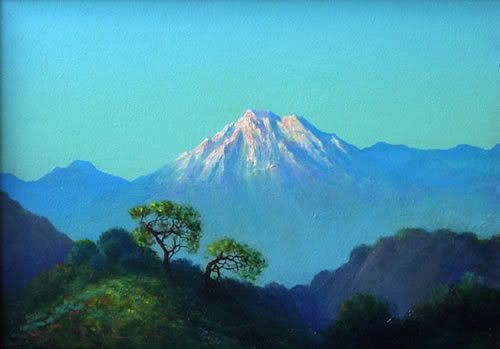
Sergeev Vladimir
Evening Landscape, 2003
Oil on canvas
Borrowed from the Amsterdam Art Gallery

Albert Bierstadt
Lake Lucerne, 1858
Oil on canvas
Borrowed from the National Gallery of Art

Frederic Edwin Church (1826 - 1900)
Heart of the Andes, 1859
Oil on canvas
Borrowed from the Metropolitan Museum of Art

Sanford Robinson Gifford (1823-1880)
A Gorge in the Mountains (Kauterskill Clove), 1862
Oil on canvas
Borrowed from the Metropolitan Museum of Art

Albert Bierstadt (1830-1902)
The Rocky Mountains, Lander's Peak, 1863
Oil on canvas
Borrowed from the Metropolitan Museum of Art

Frederic Edwin Church (1826 - 1900)
El Rio de Luz (The River of Light), 1877
Oil on canvas
Borrowed from the National Gallery of Art

George Inness (1825-1894)
Autumn Oaks, ca. 1878
Oil on canvas
Borrowed from the Metropolitan Museum of Art

Georgia O'Keeffe (1887 - 1986)
Sky with Flat White Cloud, 1962
oil on canvas
Borrowed from the National Gallery of Art

Sergeev Vladimir
Mountain Motif, 2003
Oil on canvas
Borrowed from the Amsterdam Art Gallery

Sergeev Vladimir
Evening Landscape, 2003
Oil on canvas
Borrowed from the Amsterdam Art Gallery

Wednesday, October 3, 2007
Activity #5
The two artworks I chose for my Online Museum Visit represents two entirely different themes. Jasper Johns' lithograph “0 through 9” created in 1960 represents an art and art theme. While Joseph Mallord William Turner oil on canvas painting the “Keelmen Heaving in Coals by Moonlight” in 1835 represents art in nature theme.
Johns’ “0 through 9” lithograph represents an art and art theme, where the purpose of the artwork serves to give visual pleasure. (76) In this piece, Johns’ uses lines to create shapes and movement which serves to emphasis the numbers “0 through 9”. His lines are diagonal which implies action.
Turner’s painting “Keelmen Heaving in Coals by Moonlight” represents the theme “art and nature”. He depicts the environment from his point of view. This is seen by his use of the colors orange and white to create the frames used to provide light to assist in the transfer of coal from one ship to another. Nature is represented by the illusion of moonlight breaking through the clouds to illuminate the sky and water. He creates this effect using the colors blue and white to create the lighting and darkening effect of the sky. This value serves to emphasis the sky a focus point.

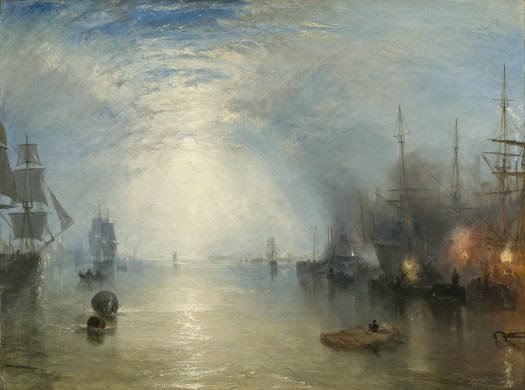
Johns’ “0 through 9” lithograph represents an art and art theme, where the purpose of the artwork serves to give visual pleasure. (76) In this piece, Johns’ uses lines to create shapes and movement which serves to emphasis the numbers “0 through 9”. His lines are diagonal which implies action.
Turner’s painting “Keelmen Heaving in Coals by Moonlight” represents the theme “art and nature”. He depicts the environment from his point of view. This is seen by his use of the colors orange and white to create the frames used to provide light to assist in the transfer of coal from one ship to another. Nature is represented by the illusion of moonlight breaking through the clouds to illuminate the sky and water. He creates this effect using the colors blue and white to create the lighting and darkening effect of the sky. This value serves to emphasis the sky a focus point.


Subscribe to:
Posts (Atom)
